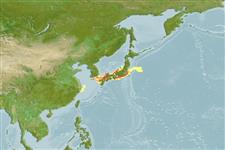>
Ophidiiformes (Cusk eels) >
Bythitidae (Livebearing brotulas)
Etymology: Parabrotula: Greek, para = the side of + Latin, brotula, -ae = little, bud, shoot (Ref. 45335); tanseimaru: Named after R/V Tansei Maru.
Eponymy: ‘Tansei Maru’ is the name of a research vessel, owned by the Ocean Research Institute, University of Tokyo (now Japan Marine Science and Technology Center), which was responsible for collecting the holotypes of the goby and false brotula. (Ref. 128868), visit book page.
More on authors: Miya & Nielsen.
Environment: milieu / climate zone / depth range / distribution range
Ecología
marino batipelágico; rango de profundidad 0 - 1300 m (Ref. 34721). Deep-water
Northwest Pacific: Japan.
Tamaño / Peso / Age
Maturity: Lm ? range ? - ? cm
Max length : 5.0 cm SL macho / no sexado; (Ref. 34721); 5.0 cm SL (female)
Occurs in pseudoceanic bathypelagic depths. Feeds primarily on copepods (Ref. 34721). Viviparous (Ref. 34721).
Life cycle and mating behavior
Madurez | Reproducción | Puesta | Huevos | Fecundidad | Larva
Miya, M. and J.G. Nielsen, 1991. A new species of the deep-sea fish genus Parabrotula (Parabrotulidae) from Sagami Bay with notes on its biology. Jap. J. Ichthyol. 38(1):1-5. (Ref. 34721)
IUCN Red List Status (Ref. 130435: Version 2024-2)
Threat to humans
Harmless
Human uses
Herramientas
Special reports
Download XML
Fuentes de Internet
Estimates based on models
Preferred temperature (Ref.
123201): 0.7 - 16.4, mean 8.5 °C (based on 34 cells).
Phylogenetic diversity index (Ref.
82804): PD
50 = 0.8750 [Uniqueness, from 0.5 = low to 2.0 = high].
Bayesian length-weight: a=0.00813 (0.00246 - 0.02688), b=2.92 (2.67 - 3.17), in cm total length, based on LWR estimates for this (Sub)family-body shape (Ref.
93245).
Nivel trófico (Ref.
69278): 3.0 ±0.00 se; based on food items.
Resiliencia (Ref.
120179): Alto, población duplicada en un tiempo mínimo inferior a 15 meses (Preliminary K or Fecundity.).
Fishing Vulnerability (Ref.
59153): Low vulnerability (10 of 100).
